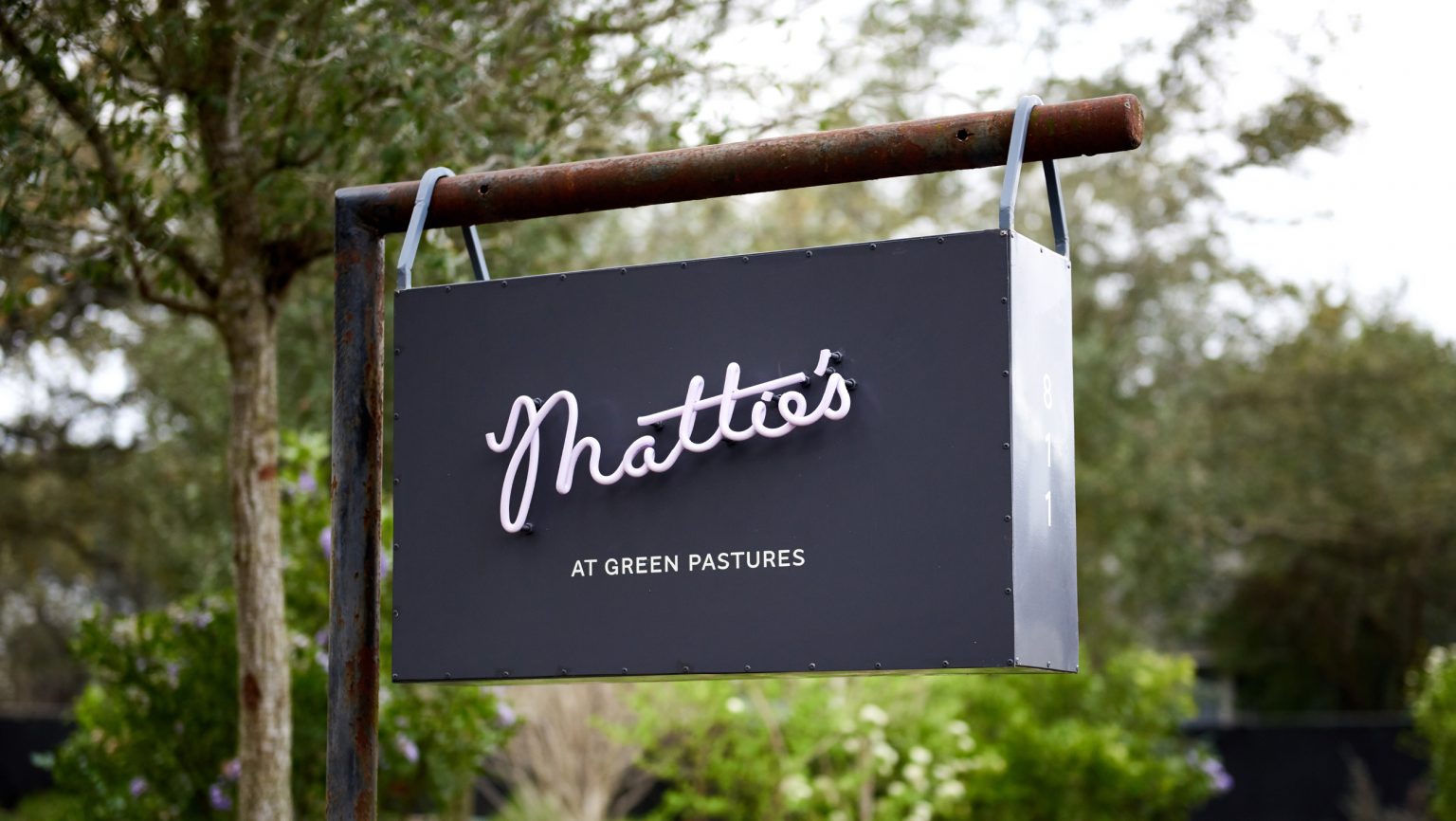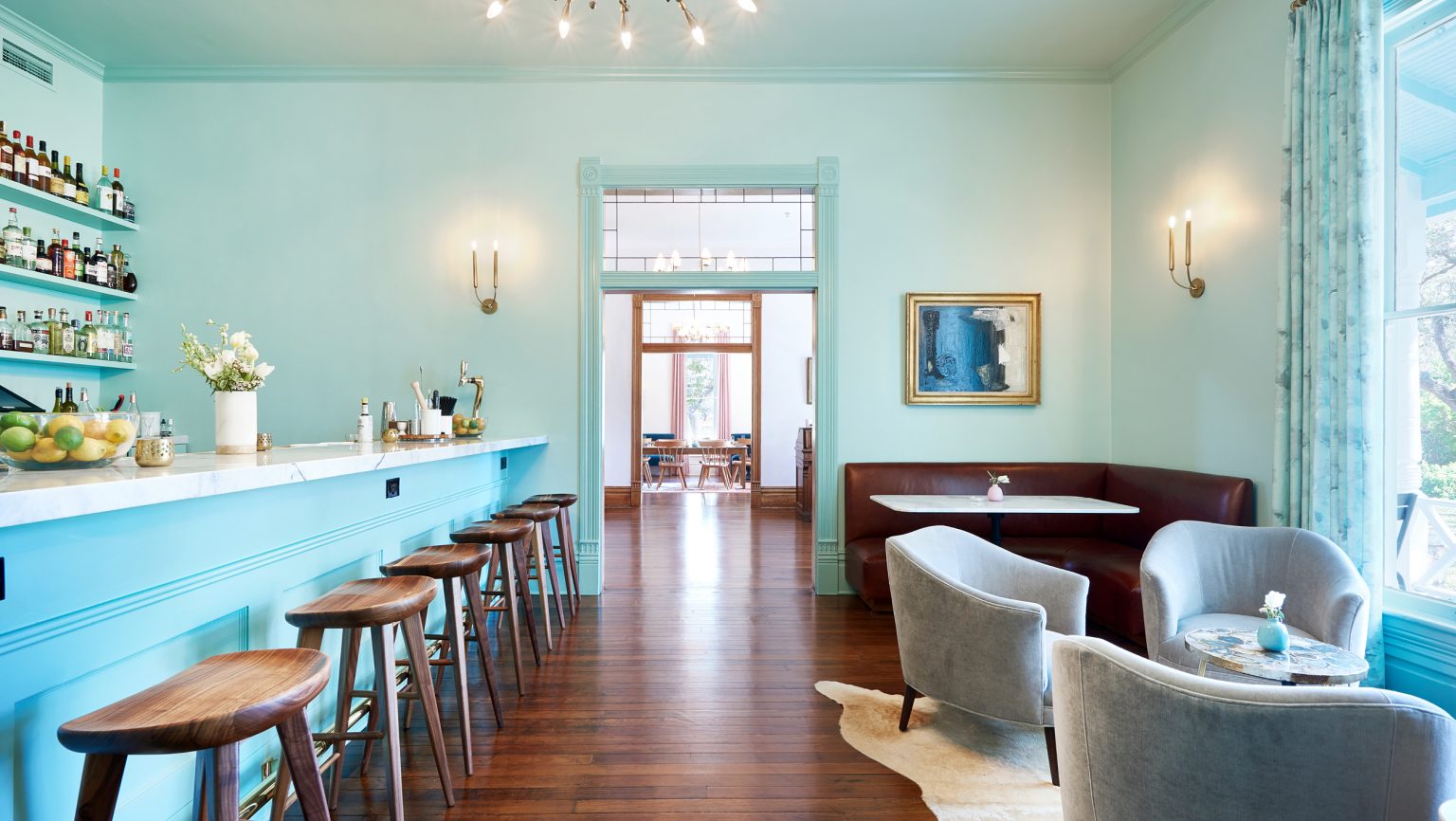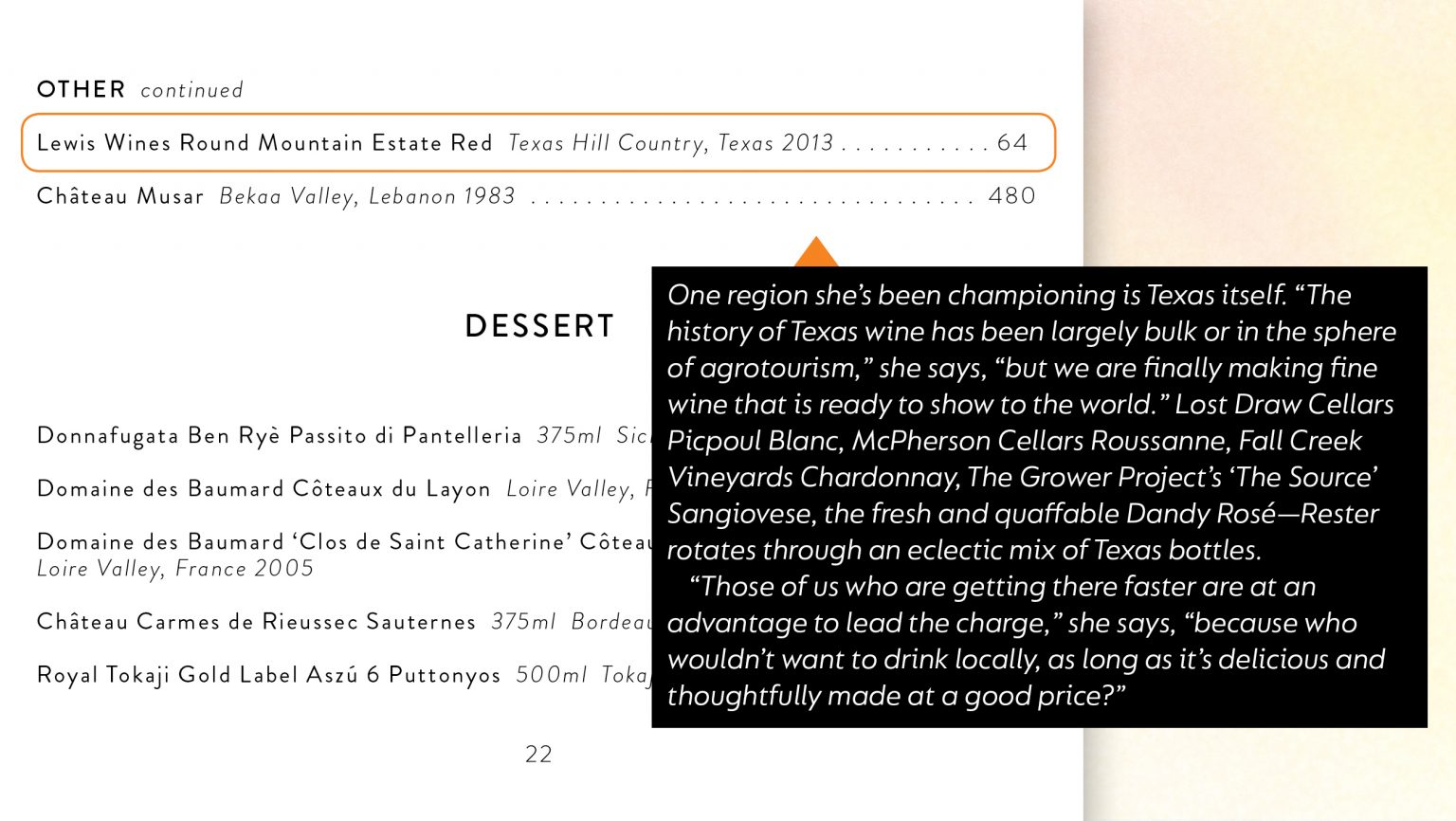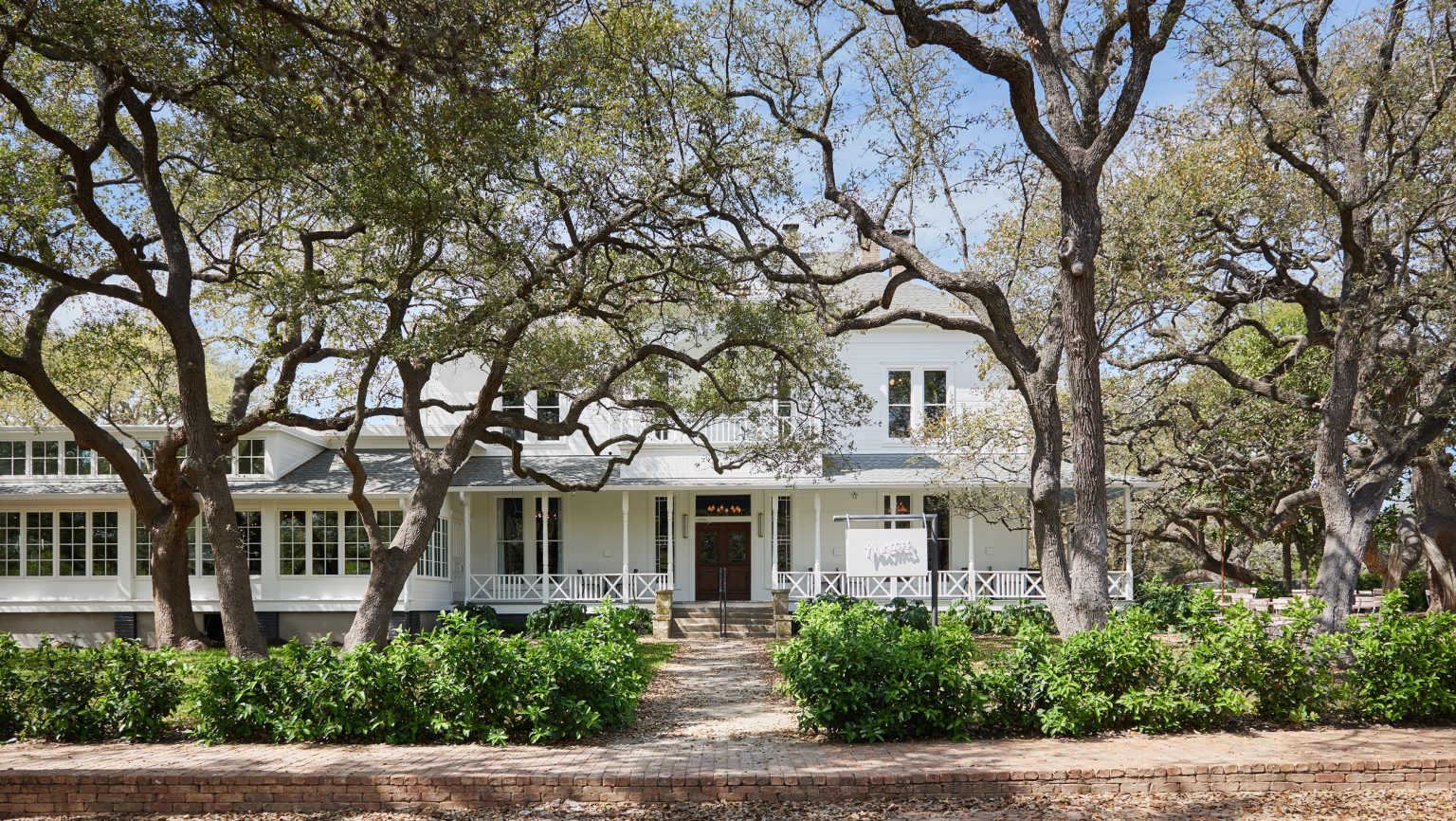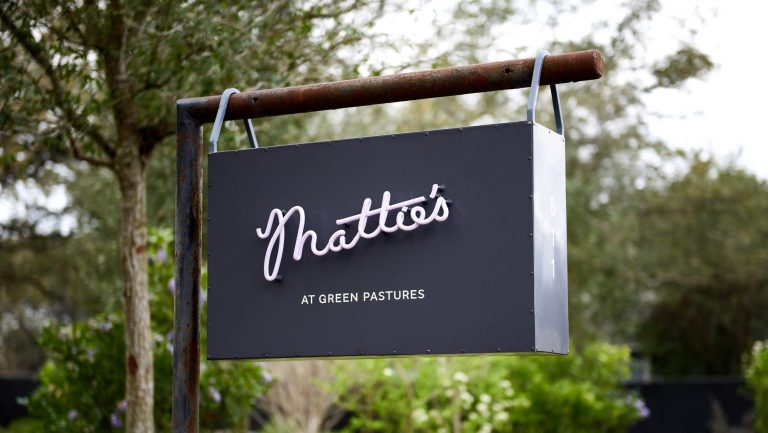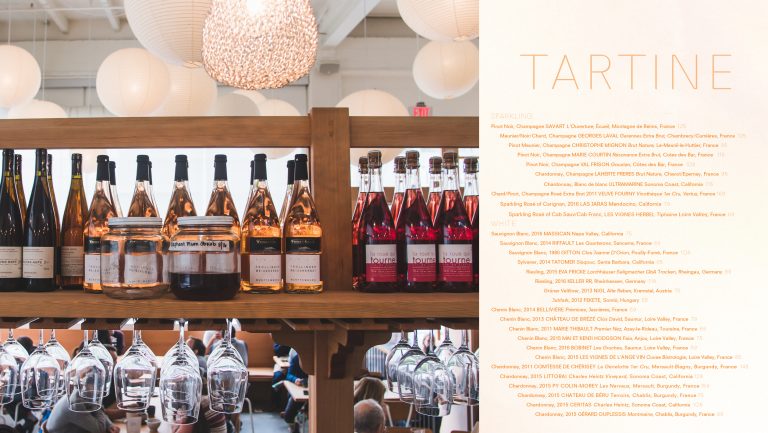“I fill my Chemex, make coffee, get back in bed, and check the [sales] reports from the night before,” says the wine director Paula Rester, of La Corsha Hospitality Group, describing her morning routine. “I always check Mattie’s first because it’s a joy to be surprised at what’s sold. It’s all over the board, which lets me know that the people walking through the doors here are very diverse.”
Open for a year and a half, Mattie’s is the newest of the Austin-based hospitality group’s current projects. On a recent afternoon, I sat down at the venue with Rester, in the grand old house of namesake Mattie Faulk, a farmer whose daughter, Mary, turned her mother’s Victorian into a restaurant back in 1946. Mary called it Green Pastures, and until the passage of the Civil Rights Act in 1964, it was about the only desegregated dining room in the area—a place where all of Austin was welcome.
Wine Is for Everyone
“The restaurant has a history of diversity and inclusivity,” Rester says, “and the fact that I’m seeing that in the way people consume on the wine list gives me a little jolt that the caffeine doesn’t.”

Don’t miss the latest drinks industry news and insights. Sign up for our award-winning newsletters and get insider intel, resources, and trends delivered to your inbox every week.
A $132 Jordan Cabernet Sauvignon ordered by a couple celebrating their 40th wedding anniversary at the same establishment where they were married; an opulent yet mineral Heidi Schröck Phoenix aus der Flasche field blend sold at a reasonable $68 to a tech-world transplant who likes to try new wines; two different Romanée-Conti Grand Crus from 2014, priced at more than $2,000 each, for a deep-pocketed Texan who wants to compare and contrast; a 1999 Ronchi di Cialla Schioppettino for $158, and a 1983 for $348, priced so that Rester’s somm pals might afford them—Mattie’s wine list, though less than 200 bottles long, makes room for them all.
“In the history and spirit of true hospitality, we don’t want to alienate anyone,” says Rester. “If I have a philosophy behind all of our programs, I’m looking for wines that are made with an eye toward sustainable agriculture, but I also want something for everyone. I like to have things that are interesting for a more adventurous drinker, more iconic producers for people who are looking for something well made and more familiar, and definitely a wide range of price points. Because wine is for everyone.”
With an estimated $5 million to $6 million in wine sales this year across La Corsha’s six properties, Rester has the wherewithal to pull off that inclusivity. And with a clear sense of what a special-occasion destination like Green Pastures has meant to her town, she’s using her wallet to build a magnanimous program at Mattie’s, where wine represents 60 to 70 percent of beverage sales. Hers is a list that pushes boundaries without imploding them.
“What Paula identified is that she can bring in some more esoteric varietals that are still easily explainable to people,” says La Corsha partner Scott Walker. “Fifteen years ago, people wanted known bottles. People are willing to try new things now. Mattie’s is headed in that direction, but at the same time, we want to make it affordable and approachable.”
Easy Reading, Gentle Pricing
Rester’s gentle revolution starts with the physical size of the list. Harking back to the space’s history as a family home, the cocktail list (overseen by Rester’s boss, Jason Stevens, La Corsha’s beverage director) and the wine list have the look and feel of 5 x 7 photo albums. No more than a dozen bottle names fit on one page—says Rester, “so you don’t get lost.”
She groups wines “in a way that anyone can understand,” she says, in a few broad varietal categories, and she uses spare language, listing just the wine name, place, vintage, and price. Under the Pinot Gris-Pinot Grigio heading, for example, are a classic Livon Braide Grande Pinot Grigio 2015 from Friuli, a fruity yet elegant Trimbach Gold Réserve Personnelle 2010 from Alsace, and an aromatic, skin-contact Robert Sinskey Abraxas Pinot Gris Blend 2013 from Carneros, California. Groupings like this allow Mattie’s staff to “create a conversation” about how one varietal is expressed in different ways across regions and producers, helping to guide guests in new directions.
Rester keeps pricing on the easy side, too. Setting margins all over the board and “shooting for a blended average,” she can offer wines she’s championing at gentle prices and pad the margins with low-cost “gems” she hunts down with the help of her sources. To make things easy on herself, she’s pared down the number of distributors she works with, concentrating on about eight who work with her favored importers, from major outfits like Skurnik, where her husband is on staff, to little guys like David Mayfield, who brings in some of her funkier selections.
“I love sparkling wines,” Rester says, as an example. “I want people to embrace drinking them at every meal. So oftentimes the margins on our sparkling wines are just 50 percent or maybe 40.”
An Emmanuel Brochet Le Mont Benoit for just $130, poured unpretentiously into a universal Riedel glass, like everything else? A Thierry Germain Bulles de Roche Saumur Brut for only $75? Rester can price these so generously because she works to nab bargains that balance the books. She poured me a Bodega Noemia A Lisa Malbec from Patagonia, part of an enormous shipment that a distributor had gotten stuck with and off-loaded on her for a song. At just $48 a bottle, it was a plummy beauty with the expressive florals you wouldn’t find in a Malbec from Mendoza.
“I think people are going to fall in love with it,” she says. “And I was able to purchase enough quantity to help me when I want to offer my Champagnes at half the normal margins.”
Glass List Does the Heavy Lifting
It helps to have the storage capacity to buy in mass. With a rockhouse cellar and two EuroCaves holding between $45,000 and $55,000 of wine at Mattie’s, Rester has room to collect. She can do most of her purchasing a year in advance, as well as explore newfound interests, like the smoky J. Bouchon País Salvaje 2017 she introduced to Austin after a trip to Chile. It’s naturally fermented from indigenous red grapes harvested, in part, from vines growing wild on trees, and Rester offers it chilled for $14 a glass.
“I tend to push the envelope with the glass list,” she says. “Because we do our printing in house, I’m not afraid to take a risk,” she says. “I like to take wines I receive in small allocations and put them on the glass list just for fun at a good price, whereas most people would hoard them.”
Partly because Rester offers such finds, “we crush glass sales,” she says. This helps her balance the books and clear out inventory, particularly during “the very aggressive happy hour.” Between 4:30 and 7 pm outside on the patio only, Mattie’s features a daily sparkling, rosé, and chilled red at $6 a glass. Rester makes a small profit, and the property’s iconic mascots provide the color. “It’s great to see the patio filled with people drinking rosé,” she says, “which you should do under Texas live oaks with peacocks walking around.”
Mattie’s banquet business provides similar benefits. Broken down by styles (crisp and dry whites, rich whites, lighter-bodied or richer reds) within a tiered pricing system and sold on a consumption basis, the banquet selections allow Rester to sell wine in volume so that she’s never stuck with too much to move.
Strong Training Yields Strong Sales
But with surprise happy-hour specials and a wine list updated weekly, with little in the way of descriptive language, Rester must rely on staff to hand sell. That’s where wine education comes in. Mattie’s has just one sommelier, Tim Mance, who’s on the floor five nights a week, and Rester herself bounces between properties. But Mattie’s servers are given ample opportunity to master the list. “We do a lot of tasting here,” says Rester. “We pop a lot of bottles and talk a lot about wine before shifts.”
That’s just the start of it. Rester also holds regular training sessions, using PowerPoint and extensive written materials. “We talk about fruit, varietal, and winemaking characteristics,” she says. “I think it’s important to be able to accurately and concisely describe how a wine will taste using words that don’t scare people, like acid.”
A portion of the training packet that deals with suggested pairings evolves as chef Josh Thomas’s globally inspired, Southern menu changes. A section called Fun Facts includes contextual information to pass on to guests who want more of a wine’s backstory. Rester also schools staff on pronunciations with repeated call-and-response “so the words feel comfortable in everyone’s mouth.” And she makes smart use of digital technologies, sending group announcements on new wines and tasting opportunities through a scheduling app, using study apps to build cheat sheets for the glass list, and hacking the recipe function in the POS system to drag and drop wine information onto the server terminals.
“My number one job is to be a cheerleader for the wine program and keep it fun and interesting,” she says. “I want to create an expectation that servers are responsible for the information as well.”
It’s an ethos of enriched staff development that she picked up from Danny Meyer’s Union Square Hospitality Group. After years of working in Austin—first as a restaurant manager, then for the distributor Serendipity, and later as wine director at Vino Vino and La Corsha’s Congress—Rester took a year to somm in New York at Meyer’s Maialino, where her big takeaway was how much opportunity she had to learn.
“I had never been in a working environment like that,” Rester says, “where any time I was curious and asked a question, I was rewarded with an educational experience. When I came back to Texas, I wanted to re-create that for our servers.”
She’s been so successful at at inspiring their passion that Mattie’s servers have formed a tasting group that meets on the restaurant’s dark night. Rester supports the group with help from her distributors, passing along bottles.
It’s Good Business to Support the Local Scene
Rester also support pros other than her own staff, inviting visiting experts, like Andreas Wickhoff of Austria’s Weingut Bründlmayer, to Mattie’s to speak to the city’s whole somm community. It’s her way of enhancing what she sees as a “spirit of cooperation and intellectual curiosity” that sets Austin’s small wine scene apart.
Others here agree with her. “We’re very open to wanting people to do their best,” says Diane Dixon. The founder of Somms Under Fire, Austin’s wine competition, as well as social media’s SommChat, Dixon is considered the patron saint of Austin’s wine community. She sees the program at Mattie’s as a sign of changing times.
“It’s a great indication of a movement in Austin to accept broader wine lists, with both Old World and New World and varying price points, so that a broad range of diners can be satisfied,” says Dixon. That’s great because the more wine Austin drinks, “the more access we have to getting the wines here.” Thanks to pros like Rester, Dixon says, Austin has “become a destination. Winemakers don’t want to miss showing their wines off to our pros.”
Restaurant group wine directors like Rester, or McGuire Moorehouse Hospitality’s June Rodil, under whom Rester worked at Congress, have bully pulpits with which to aid the cause. Says Rester, “I use social media and work with our PR firm when we do brand launches or introduce something new to the market.”
One region she’s been championing is Texas itself. “The history of Texas wine has been largely bulk or in the sphere of agrotourism,” she says, “but we are finally making fine wine that is ready to show to the world.” Lost Draw Cellars Picpoul Blanc, McPherson Cellars Roussanne, Fall Creek Vineyards Chardonnay, The Grower Project’s The Source Sangiovese, the fresh and quaffable Dandy Rosé—Rester reels off an eclectic mix of Texas bottles.
“Those of us who are getting there faster are at an advantage to lead the charge,” she says, “because who wouldn’t want to drink locally, as long as it’s delicious and thoughtfully made at a good price?”
She realized there was “a disconnect” when the trade portion of a Texas growers event she held at Mattie’s was not as well attended as the sold-out consumer hours. But Texas producers are part of the Austin wine scene as well, and Rester’s boosterism on their behalf is very much in keeping with her “Wine is for everybody” ethos.
“There are great wines being made here,” she exclaims. “There are people that want to drink them. You gotta get those wines on your list.”

Dispatch
Sign up for our award-winning newsletter
Don’t miss the latest drinks industry news and insights—delivered to your inbox every week.
Betsy Andrews is an award-winning journalist and poet. Her latest book is Crowded. Her writing can be found at betsyandrews.contently.com.

